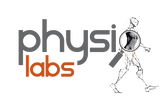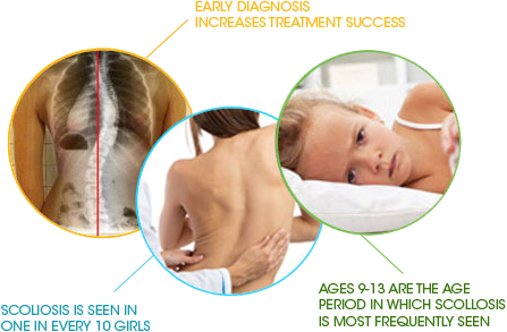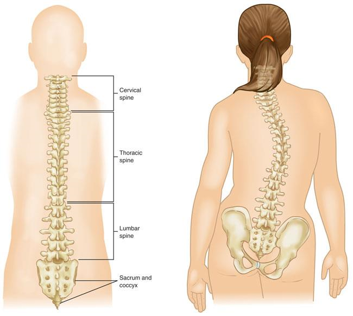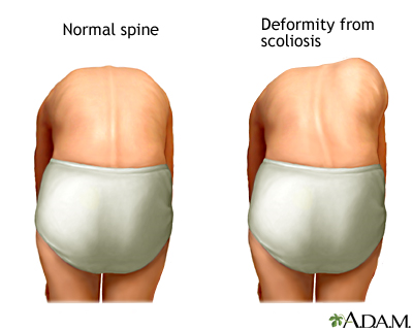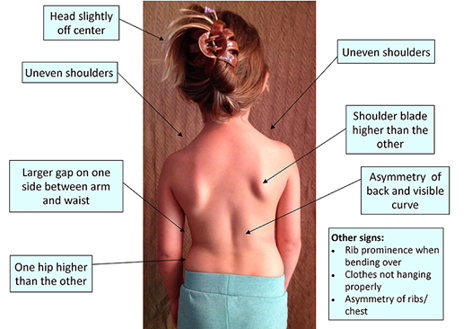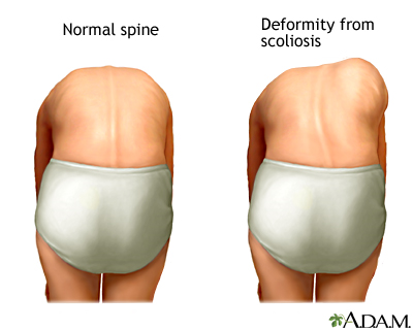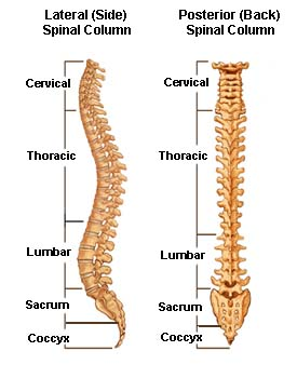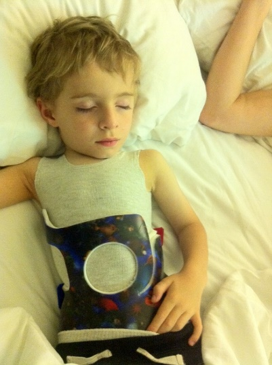4 Tests to Know If Your Child Has Scoliosis
Early identification of scoliosis helps in quicker recovery. 3 to 4% of Australians have scoliosis.
Scoliosis usually occurs in childhood and severity may increase with age. Severe scoliosis changes the looks, posture, and causes health issues such as breathing problems. If you identify it late, your child may not completely recover and may need a surgery to fix the spine; thus, early identification is a must.
What is scoliosis?
Scoliosis is when your spine/ backbone has a different curve than it should. When you look from the back, spine is usually straight. Here’s a picture of normal spine. The second half of the picture shows scoliosis.
What is scoliosis?
Scoliosis is when your spine/ backbone has a different curve than it should. When you look from the back, spine is usually straight. Here’s a picture of normal spine. The second half of the picture shows scoliosis.
In scoliosis, spine bends on one side. However, a curvature of up-to ten degrees is normal, but, anything above that we call it scoliosis.
In the above image, the first picture that you see is of a normal spine and the second one is of scoliosis.
Here are the symptoms of scoliosis
Here are the symptoms of scoliosis
- Uneven shoulders
- Uneven hips
- Uneven clothes: One leg of the pant may be shorter than the other/ one sleeve of the shirt may be shorter than the other/ hemline may be uneven.
*Hemline is the lower line of your clothing: shirt/ suit/ skirt. - Rounded back
- Waist and trunk shift to a side
- Ribs may be prominent on one side
As scoliosis gets severe, in addition to moving on the side, spine may also turn and twist. These changes make ribs on one side of the body come out than the other.
Complications of scoliosis
Severe scoliosis can result in the following complications:
Affects breathing
Ribs/ chest bone may press against your lungs and cause difficulty in breathing.
Affects heart
Ribs may press on your heart; thus, your heart may not be able to pump the blood effectively.
Back pain
Scoliosis can cause back pain.
Appearance
Scoliosis affects the appearance. As scoliosis gets worse, it may affect the confidence of the affected individual.
Causes of scoliosis
80% of scoliosis is idiopathic, which means there is no specific cause.
There are three types of Idiopathic scoliosis, which are based on the age of onset.
20% of scoliosis has known causes. The causes are structural and non-structural.
Non-structural causes of scoliosis
Here the spine works normally but looks curved due to some other causes which are not directly related to the structure of spine. Diseases such as appendicitis, muscle spasms, and one leg being longer than the other are few of the non-structural causes of scoliosis. When you correct these causes, spine becomes normal.
Structural causes of scoliosis
Here the spine is curved by structure. Birth defects, infection, tumor, and diseases such as cerebral palsy and muscular dystrophy are few of the structural causes of scoliosis.
Usually, scoliosis starts appearing when the child is 10 to 15 years old.
Here’s another classification of scoliosis which we use often.
Early scoliosis
Early scoliosis manifests before the age of five. We need to treat this early. If not organs such as heart and lungs may not develop properly as deviated position of spine interferes with their growth. This, in turn, leads to breathing problems and high blood pressure in the later years.
Late scoliosis
Late scoliosis is the scoliosis that occurs after the age of five. This does not have a huge impact on the growth of heart and lungs as most of the growth is over by the age of five.
Degenerative scoliosis
Another type of scoliosis known as degenerative scoliosis occurs with aging. This is due to the bones which wear out with age, thus, there is a change in the angle of spine.
Who is at risk of developing scoliosis?
Diagnosis
Here are few tips to help you know if your child has scoliosis.
4 Tests to Know If Your Child Has Scoliosis
If any of your family member has scoliosis, check often for the signs of scoliosis in your child. Here are 4 tests:
1. Forward bend test Forward bend test is a popular test for scoliosis.
Ask your child to bend forward with his/ her feet together, knees straight, while letting the arms loose or hanging. Usually, in scoliosis, the right side of shoulder is higher than the left side during the front bend test. Examine the back from behind and from the front side.
Complications of scoliosis
Severe scoliosis can result in the following complications:
Affects breathing
Ribs/ chest bone may press against your lungs and cause difficulty in breathing.
Affects heart
Ribs may press on your heart; thus, your heart may not be able to pump the blood effectively.
Back pain
Scoliosis can cause back pain.
Appearance
Scoliosis affects the appearance. As scoliosis gets worse, it may affect the confidence of the affected individual.
Causes of scoliosis
80% of scoliosis is idiopathic, which means there is no specific cause.
There are three types of Idiopathic scoliosis, which are based on the age of onset.
- Infantile Here scoliosis develops before the child reaches the age of two. 90% of the times, this kind of scoliosis heals on its own. This type of scoliosis is rare in Australia.
- Juvenile This develops when the child is two to ten years old. This is also a rare occurrence in Australia.
- Adolescent As the name suggests, this type of scoliosis is visible after 10 years of age. It affects girls more than boys.
20% of scoliosis has known causes. The causes are structural and non-structural.
Non-structural causes of scoliosis
Here the spine works normally but looks curved due to some other causes which are not directly related to the structure of spine. Diseases such as appendicitis, muscle spasms, and one leg being longer than the other are few of the non-structural causes of scoliosis. When you correct these causes, spine becomes normal.
Structural causes of scoliosis
Here the spine is curved by structure. Birth defects, infection, tumor, and diseases such as cerebral palsy and muscular dystrophy are few of the structural causes of scoliosis.
Usually, scoliosis starts appearing when the child is 10 to 15 years old.
Here’s another classification of scoliosis which we use often.
Early scoliosis
Early scoliosis manifests before the age of five. We need to treat this early. If not organs such as heart and lungs may not develop properly as deviated position of spine interferes with their growth. This, in turn, leads to breathing problems and high blood pressure in the later years.
Late scoliosis
Late scoliosis is the scoliosis that occurs after the age of five. This does not have a huge impact on the growth of heart and lungs as most of the growth is over by the age of five.
Degenerative scoliosis
Another type of scoliosis known as degenerative scoliosis occurs with aging. This is due to the bones which wear out with age, thus, there is a change in the angle of spine.
Who is at risk of developing scoliosis?
- Family history
If you or any of your family member has scoliosis, your child may develop scoliosis. Be sure to examine your child often for scoliosis. - Gender
Girls are 8 to 10 times at higher risk of developing severe scoliosis than boys. - Age
Kids are at higher risk of developing scoliosis during puberty which is typically around 10 to 15 years of age. Girls are at a higher risk of scoliosis at age 7 and age 9. - Body type
Those with a thin and lanky body are at higher risk.
Diagnosis
Here are few tips to help you know if your child has scoliosis.
4 Tests to Know If Your Child Has Scoliosis
If any of your family member has scoliosis, check often for the signs of scoliosis in your child. Here are 4 tests:
1. Forward bend test Forward bend test is a popular test for scoliosis.
Ask your child to bend forward with his/ her feet together, knees straight, while letting the arms loose or hanging. Usually, in scoliosis, the right side of shoulder is higher than the left side during the front bend test. Examine the back from behind and from the front side.
As you see in the image above, the first picture is that of a normal spine and the second one is scoliosis. Any deviation in the ribcage/ chest bone and or any other deformity at the back may indicate scoliosis.
2. Stand straight test
Another test is to ask your child to stand straight. Examine your child from the front, back and from the sides and check for the symptoms of scoliosis which are mentioned above.
3. Clothes test
Check if your child has uneven or ill-fitting clothing and look for the hemline.
4. Walking test
Ask your child to walk and check if
If you sense any deviation talk to your family doctor. Early diagnosis is always the best.
Your doctor may conduct a physical examination and also order X-ray. X-ray usually shows a bend in the thoracic region. The picture below shows a normal spine and its divisions including thoracic.
2. Stand straight test
Another test is to ask your child to stand straight. Examine your child from the front, back and from the sides and check for the symptoms of scoliosis which are mentioned above.
3. Clothes test
Check if your child has uneven or ill-fitting clothing and look for the hemline.
4. Walking test
Ask your child to walk and check if
- Your child limps slightly while walking
- Your child’s one leg appears shorter than the other
- Your child’s body tilts on one side
If you sense any deviation talk to your family doctor. Early diagnosis is always the best.
Your doctor may conduct a physical examination and also order X-ray. X-ray usually shows a bend in the thoracic region. The picture below shows a normal spine and its divisions including thoracic.
Treatment
If you recognize scoliosis early, you can reduce the curve with the help of exercises meant for scoliosis. The late recognition has impacts such as threefold aggravation. The treatment is extensive in such cases. Here are the treatment options for scoliosis:
1. Exercise
Exercises help the child to correct the muscles that support spine. They train your child’s brain and your child gets into the habits which support a straighter spine. A child who starts exercising for scoliosis before the curve reaches 20 degrees, can reduce the curvature to less than 10 degrees (which is normal) with right exercises.
2. Braces
Few children may need braces too. Braces prevent the worsening of curve. If your child who is in the growth years has scoliosis, braces are of help. The more your child wears the brace, the more is the result. Braces are more effective for moderate scoliosis but be sure to start them early. Make sure your child wears it for the prescribed time for best results. Meet your doctor every three months.
If you recognize scoliosis early, you can reduce the curve with the help of exercises meant for scoliosis. The late recognition has impacts such as threefold aggravation. The treatment is extensive in such cases. Here are the treatment options for scoliosis:
1. Exercise
Exercises help the child to correct the muscles that support spine. They train your child’s brain and your child gets into the habits which support a straighter spine. A child who starts exercising for scoliosis before the curve reaches 20 degrees, can reduce the curvature to less than 10 degrees (which is normal) with right exercises.
2. Braces
Few children may need braces too. Braces prevent the worsening of curve. If your child who is in the growth years has scoliosis, braces are of help. The more your child wears the brace, the more is the result. Braces are more effective for moderate scoliosis but be sure to start them early. Make sure your child wears it for the prescribed time for best results. Meet your doctor every three months.
However, braces do not correct a curve, but they prevent the progression or worsening of the spinal curve. Any correction which you may feel while using braces are undone once the treatment stops. The curve comes back after stopping treatment.
3. Surgery
In late scoliosis, treatment involves fusing the bent spine, however, this surgery does not let the spine grow further in that area. As 80% of the growth of spine is over by the age of 10, doctors may perform this surgery after the age of ten, but they avoid this treatment in early scoliosis.
Scoliosis screening at school
Scoliosis screening at school is usually a two-tier approach
The first screening is by the school nurses who are well versed with the forward bend test.
The second round of screening is by the doctor.
In school screening, if the child has scoliosis, inform the parents only after the second round of screening which is by the doctor. This avoids unnecessary apprehension. Up to 3% of school children may have scoliosis.
These days in certain areas there is no screening for scoliosis at school. Thus, the government has come up with National Self Detection Program for Scoliosis. Via this program, schools distribute a brochure which details for the self-detection of scoliosis to girls who are of age 7 and age 9. This helps in the early detection. Be sure to talk to your family doctor on this. However, most of the scoliosis which is diagnosed in this age does not need active treatment as it may correct on its own, thus, avoid referring to specialists. Your family doctor’s help is more than enough.
As early detection of scoliosis helps in better treatment outcomes, encourage screening for scoliosis at school. Screening at age 7 is crucial for girls. The next crucial age for girls is age 9.
3. Surgery
In late scoliosis, treatment involves fusing the bent spine, however, this surgery does not let the spine grow further in that area. As 80% of the growth of spine is over by the age of 10, doctors may perform this surgery after the age of ten, but they avoid this treatment in early scoliosis.
Scoliosis screening at school
Scoliosis screening at school is usually a two-tier approach
The first screening is by the school nurses who are well versed with the forward bend test.
The second round of screening is by the doctor.
In school screening, if the child has scoliosis, inform the parents only after the second round of screening which is by the doctor. This avoids unnecessary apprehension. Up to 3% of school children may have scoliosis.
These days in certain areas there is no screening for scoliosis at school. Thus, the government has come up with National Self Detection Program for Scoliosis. Via this program, schools distribute a brochure which details for the self-detection of scoliosis to girls who are of age 7 and age 9. This helps in the early detection. Be sure to talk to your family doctor on this. However, most of the scoliosis which is diagnosed in this age does not need active treatment as it may correct on its own, thus, avoid referring to specialists. Your family doctor’s help is more than enough.
As early detection of scoliosis helps in better treatment outcomes, encourage screening for scoliosis at school. Screening at age 7 is crucial for girls. The next crucial age for girls is age 9.
References:
- https://medlineplus.gov/ency/imagepages/19465.htm
- https://pediatriceducation.org/2017/12/04/how-do-you-perform-the-adams-forward-bend-test/
- https://www.mayoclinic.org/diseases-conditions/scoliosis/symptoms-causes/syc-20350716
- https://www.webmd.com/back-pain/causes-scoliosis
- https://www.safetyandquality.gov.au/wp-content/uploads/2015/11/SAQ201_04_Chapter3_v6_FILM_tagged_merged_3-3.pdf
- https://www.ncbi.nlm.nih.gov/pmc/articles/PMC1808441/
- http://www.rightdiagnosis.com/s/scoliosis/stats-country.htm
- https://www.webmd.com/back-pain/brace-orthotic-treatment-for-scoliosis
- https://www.ncbi.nlm.nih.gov/pmc/articles/PMC3566258/
- http://www.scoliosis-australia.org/scoliosis/about_scoliosis.htm
References for Images:
- http://skolyozkorsesi.com/kronikweb-assets/kronikweb-images/cuff-image_en.png
- https://orthoinfo.aaos.org/globalassets/figures/a00353f01.jpg
- https://static1.squarespace.com/static/5578eb50e4b0427d6ed72ff8/t/5930fea1be6594842feba063/1496383144139/scoliosis.jpg
- https://medlineplus.gov/ency/images/ency/fullsize/19465.jpg
- http://boneandspine.com/wp-content/uploads/2007/10/spine.jpg
- http://girltomom.com/wp-content/uploads/2011/07/Bexnewbrace-e1310656109290-764x1024.jpg
